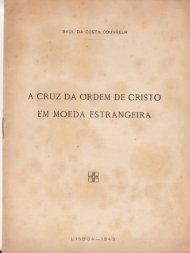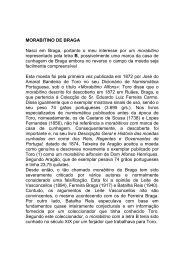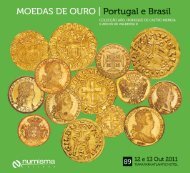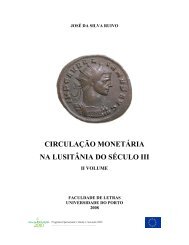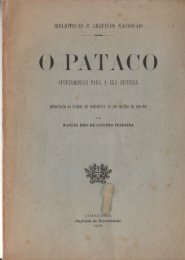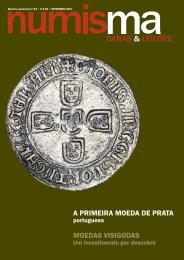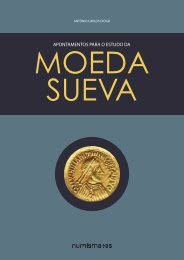Silver Pfennigs and Small Silver Coins of Europe in the Middle Ages
Silver Pfennigs and Small Silver Coins of Europe in the Middle Ages
Silver Pfennigs and Small Silver Coins of Europe in the Middle Ages
Create successful ePaper yourself
Turn your PDF publications into a flip-book with our unique Google optimized e-Paper software.
Leopold VI., 1195 - 1230<br />
Leopold VI (1176 – 28 July 1230), called <strong>the</strong> Glorious, from <strong>the</strong> House <strong>of</strong> Babenberg, was Duke <strong>of</strong> Austria from 1198 to 1230 <strong>and</strong><br />
<strong>of</strong> Styria from 1194 to 1230.<br />
Leopold was <strong>the</strong> younger son <strong>of</strong> Duke Leopold V. In contravention <strong>of</strong> <strong>the</strong> provisions <strong>of</strong> <strong>the</strong> Georgenberg Pact, <strong>the</strong> Babenberg reign<br />
was divided after <strong>the</strong> death <strong>of</strong> Leopold V: Leopold's elder bro<strong>the</strong>r, Frederick I, was given <strong>the</strong> Duchy <strong>of</strong> Austria (correspond<strong>in</strong>g<br />
roughly to modern Lower Austria <strong>and</strong> eastern Upper Austria), while Leopold himself became Duke <strong>of</strong> Styria. Both duchies were<br />
reunified when Frederick died after only four years <strong>of</strong> rule.<br />
Leopold VI participated <strong>in</strong> <strong>the</strong> Reconquista <strong>in</strong> Spa<strong>in</strong> <strong>and</strong> <strong>in</strong> two crusades, <strong>the</strong> Albigensian Crusade <strong>in</strong> 1212 <strong>and</strong> <strong>the</strong> failed Fifth<br />
Crusade from 1217 to 1221, <strong>and</strong>—like his predecessors—attempted to develop <strong>the</strong> l<strong>and</strong> by found<strong>in</strong>g monasteries. His most important<br />
foundation is Lilienfeld <strong>in</strong> <strong>the</strong> Lower Austrian valley <strong>of</strong> <strong>the</strong> Traisen river, where he was buried after his death. Besides that, he<br />
supported <strong>the</strong> <strong>the</strong>n highly modern Mendicant Orders <strong>of</strong> <strong>the</strong> Franciscans <strong>and</strong> Dom<strong>in</strong>icans. He elevated Enns to <strong>the</strong> status <strong>of</strong> a city<br />
<strong>in</strong> 1212, <strong>and</strong> Vienna <strong>in</strong> 1221, <strong>the</strong> territory <strong>of</strong> which was nearly doubled.<br />
Under Leopold's rule, <strong>the</strong> Gothic style began to reach Austria - <strong>the</strong> Cappella Speciosa <strong>in</strong> his temporary residence <strong>of</strong><br />
Klosterneuburg is known as <strong>the</strong> first build<strong>in</strong>g <strong>in</strong>fluenced by it <strong>in</strong> <strong>the</strong> Danube area - a reconstruction <strong>of</strong> it can be seen today <strong>in</strong> <strong>the</strong><br />
palace gardens <strong>of</strong> Laxenburg.<br />
Babenbergian Austria reached <strong>the</strong> zenith <strong>of</strong> its prestige under Leopold's rule. Evidence <strong>of</strong> this is given by his marriage to <strong>the</strong><br />
Byzant<strong>in</strong>e pr<strong>in</strong>cess Theodora Angel<strong>in</strong>a <strong>and</strong> his attempt to mediate between Holy Roman Emperor Frederick II <strong>and</strong> Pope Gregory<br />
IX, which he was work<strong>in</strong>g on when he died <strong>in</strong> 1230 <strong>in</strong> Italy.<br />
Leopold's court is known as a center <strong>of</strong> <strong>the</strong> M<strong>in</strong>nesang, e.g., Wal<strong>the</strong>r von der Vogelweide, Neidhart von Reuental <strong>and</strong> Ulrich von<br />
Liechtenste<strong>in</strong> were active here. Also, <strong>the</strong> Nibelungenlied may have been written <strong>in</strong> his court.<br />
Leopold died at San Germano <strong>in</strong> 1230.<br />
Leopold V 1192-1194<br />
Leopold V (1157 – December 31, 1194), <strong>the</strong> Virtuous, was a Babenberg duke <strong>of</strong> Austria from 1177 to 1194 <strong>and</strong> Styria from 1192<br />
to 1194.<br />
Leopold was <strong>the</strong> son <strong>of</strong> Henry II Jasomirgott <strong>and</strong> his Byzant<strong>in</strong>e wife Theodora Comnena. In 1172 he married Helena, daughter <strong>of</strong><br />
K<strong>in</strong>g Géza II <strong>of</strong> Hungary, <strong>and</strong> <strong>the</strong>ir sons were Frederick I <strong>and</strong> Leopold VI.<br />
On August 17, 1186 <strong>the</strong> Georgenberg Pact was negotiated, by which Styria <strong>and</strong> <strong>the</strong> central part <strong>of</strong> Upper Austria were amalgamated<br />
<strong>in</strong>to <strong>the</strong> Duchy <strong>of</strong> Austria after 1192. This was <strong>the</strong> first step towards <strong>the</strong> creation <strong>of</strong> modern Austria.<br />
Leopold is ma<strong>in</strong>ly remembered outside Austria for his participation <strong>in</strong> <strong>the</strong> Third Crusade. He arrived to take part <strong>in</strong> <strong>the</strong> siege <strong>of</strong><br />
Acre <strong>in</strong> spr<strong>in</strong>g 1191, hav<strong>in</strong>g sailed from Zadar on <strong>the</strong> Adriatic coast. He took over comm<strong>and</strong> <strong>of</strong> what rema<strong>in</strong>ed <strong>of</strong> <strong>the</strong> imperial<br />
forces after <strong>the</strong> death <strong>of</strong> Frederick VI, Duke <strong>of</strong> Swabia <strong>in</strong> January.<br />
After Acre surrendered, <strong>the</strong> banners <strong>of</strong> <strong>the</strong> K<strong>in</strong>gdom <strong>of</strong> Jerusalem, Richard I <strong>of</strong> Engl<strong>and</strong>, Philip II <strong>of</strong> France <strong>and</strong> Leopold were<br />
raised <strong>in</strong> <strong>the</strong> city by Leopold's cous<strong>in</strong>, Conrad <strong>of</strong> Montferrat. However, Richard removed Leopold's flag (see Siege <strong>of</strong> Acre).<br />
Richard was also suspected <strong>of</strong> <strong>in</strong>volvement <strong>in</strong> <strong>the</strong> murder <strong>of</strong> Conrad, shortly after his election as K<strong>in</strong>g <strong>of</strong> Jerusalem <strong>in</strong> April 1192.<br />
On his journey back that w<strong>in</strong>ter, Richard, travell<strong>in</strong>g <strong>in</strong> disguise, had to stop <strong>in</strong> Vienna, where he was recognized (supposedly<br />
because <strong>of</strong> his signet r<strong>in</strong>g) <strong>and</strong> was arrested <strong>in</strong> <strong>the</strong> Erdberg district (modern L<strong>and</strong>straße). For some time <strong>the</strong> k<strong>in</strong>g was imprisoned<br />
<strong>in</strong> Dürnste<strong>in</strong>, <strong>and</strong> was <strong>the</strong>n brought before Emperor Henry VI, <strong>and</strong> accused <strong>of</strong> Conrad's murder. The immense ransom, supposedly<br />
six thous<strong>and</strong> buckets <strong>of</strong> silver, became <strong>the</strong> foundation for <strong>the</strong> m<strong>in</strong>t <strong>in</strong> Vienna, <strong>and</strong> was used to build new city walls for<br />
Vienna, as well as to build Wiener Neustadt. However, <strong>the</strong> duke was excommunicated by Pope Celest<strong>in</strong>e III for hav<strong>in</strong>g taken a<br />
fellow crusader prisoner.<br />
In 1194 Leopold's foot was crushed when his horse fell on him at a tournament <strong>in</strong> Graz. He died <strong>of</strong> gangrene, still under excommunication.<br />
Austria<br />
Duchy <strong>of</strong> Steiermark<br />
Leopold VI., 1194 - 1230<br />
Pfennig M<strong>in</strong>t: Graz. 18 mm 0 ,92g.<br />
Obv.: Bridge between 2 towers, deer head with rosette above between towers.<br />
Rev.: Lion right. Stars <strong>in</strong> field, r<strong>in</strong>glet circle all around.<br />
Reference: CNA D3. VF. *Probably commemorative penny <strong>of</strong> build<strong>in</strong>g <strong>of</strong> Ste<strong>in</strong>brück Bridge<br />
about 1220!<br />
Estimate: EUR 150.



